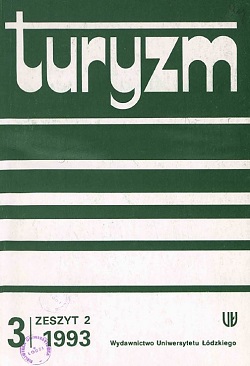The Structure and Atractiveness of the Tourist Space of Poland in the Opinion of the Chosen Group of Toruń Inhabitants
DOI:
https://doi.org/10.18778/0867-5856.3.2.02Abstract
Opracowanie zawiera rezultaty badania, ktorego celem było poznanie: 1) struktury przestrzeni turystycznej naszego kraju, spostrzeganej przez grupę urzędnikow administracyjnych m. Torunia; 2) ocen atrakcyjności turystycznej miejscowości i obszarów budujących tę strukturę, przy zastosowaniu jednej z metod skalowania - dyferencjału semantycznego.
Downloads
References
Czapiński J., 1978, Dyferencjał semantyczny, „Materiały do Nauczania Psychologii”, PWN, Warszawa, Ser. 3, t. 3, s. 257-275.
Google Scholar
Fenton M., Pearce P., 1988, Multidimensional Scaling and Tourism Research, „Annals of Tourism Research”, vol. 15, s. 236-254.
Google Scholar
DOI: https://doi.org/10.1016/0160-7383(88)90085-0
Fridgen J. D., 1987, Use of Cognitive Maps to Determine Perceived Tourism Regions, „Leisure Sciences”, vol. 9, s. 101-117.
Google Scholar
DOI: https://doi.org/10.1080/01490408709512150
Husbands W., 1983, Tourist Space and Touristic Attraction. An Analysis of the Destination Choices of European Travelers, „Leisure Sciences”, vol. 5, s. 289-307.
Google Scholar
DOI: https://doi.org/10.1080/01490408309513010
Lijewski T., Mikułowski B., Wyrzykowski J., 1992, Geografia turystyki Polski, PWN, Warszawa.
Google Scholar
Mayntz R., Holm R.,Hubner P., 1985, Wprowadzenie do metod socjologii empirycznej, PWN, Warszawa.
Google Scholar
Downloads
Published
How to Cite
Issue
Section
License

This work is licensed under a Creative Commons Attribution-NonCommercial-NoDerivatives 4.0 International License.










